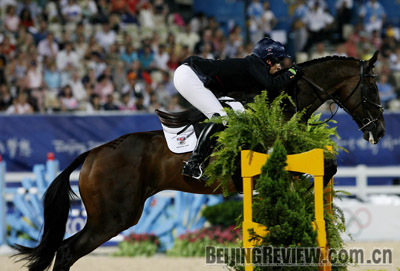|
|

|
|
A CLEAN JUMP: Kristina Cook of Great Britain and her horse leap over a fence at the Sha Tin Olympic venue in Hong Kong on August 12. Cook won two bronze medals that day in the jumping phase of the team and individual eventing competitions |
While the new and highly impressive Olympic venues in Beijing have received the lion's share of media attention, the two main equestrian venues in Hong Kong are worthy of the spotlight in their own right.
The venues at Sha Tin and Beas River are two of THE most technologically advanced equestrian facilities in the world. The Hong Kong Jockey Club, the organizer of the Olympic equestrian events, spent more than HK$1.2 billion ($153.7 million) and about two years on the design, construction, refurbishment and maintenance of its racing facilities at Sha Tin and a cross-country course at the Beas River Country Club, both in the city's New Territories region.
Sha Tin, the main venue, is hosting the dressage competition, during which horses perform controlled movements, and jumping events, while Beas River is hosting the cross-country portion of the eventing competition, from August 9-21. Both venues will be used for the Paralympic equestrian events in September.
A team of architects and engineers converted the main venue from the existing Hong Kong Sports Institute, the city's training ground for top athletes, and from nearby Penfold Park, where additional training tracks, as well as a special sandy area for horses to relax, are located. The institute's refurbished building now houses offices for the Olympic equestrian competition management, a reception area for VIPs, accommodations for horse grooms and the main press center.
No expense spared
The Hong Kong Jockey Club spared no expense in outfitting the venues with the latest technology. The facilities have integrated systems for access, fire alarms, elevators and plumbing, all of which are usually controlled separately, according to Linda Lee, a senior consultant in the Jockey Club's public affairs department. Technicians at computer terminals can monitor and adjust these functions remotely. And the buildings' air-conditioning systems are water-chilled, reducing operating costs by 30 percent over conventional systems.
An equine hospital provides first-rate diagnostic machines and instruments for high-definition x-rays and scans. The racing laboratory is one of only four in the world, and the only one in Asia, approved by the International Equestrian Federation to test horses for performance-enhancing drugs, Lee said in an e-mail interview. It has been conducting the first onsite testing of equine blood and urine samples during an Olympic Games, she said.
Workers installed hi-tech floodlights at Sha Tin but arranged them so that they would minimize shadows that sometimes cause horses to miscalculate jumps. To placate concerns about how the city's subtropical climate and high humidity would affect the horses' health, organizers outfitted Sha Tin with several mobile cooling units and four stationary ones with misting tents to cool down horses after training and events. In the competition area, they also added footing made of a mix of fine quartz sand, textiles and fibers to support horses' legs and drain rainwater quickly, should the city experience any typhoons during the Olympics.
|
